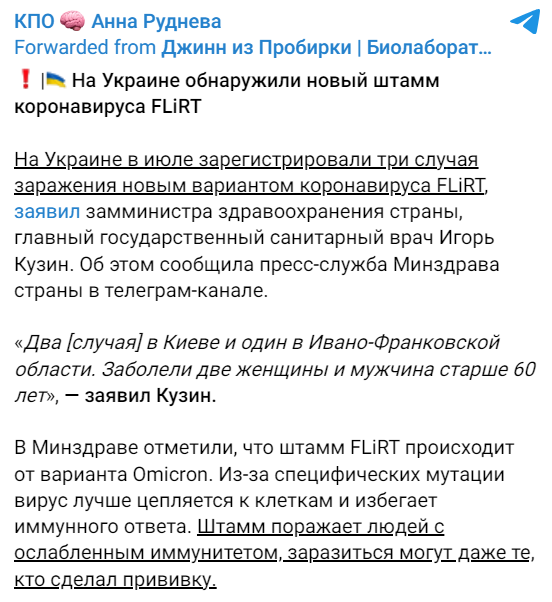This summer, the number of COVID-19 cases in Ukraine is increasing, and the first cases of infection with the new virus subvariant FLiRT were recorded in July. Russian propagandists, in their usual manner, presented this news as proof that “Ukraine is a testing ground where the West experiments with everything, including viruses”.
With the support of the USAID Health Reform Support project, VoxCheck analyzes and refutes public health narratives spread in the information space of Ukraine, Belarus, and russia on a weekly basis.
There is information being spread online that the emergence of the new coronavirus subvariant FLiRT in Ukraine is evidence of it being used as a “testing ground for new weapons”.
Screenshot of the post
What’s the reality?
The narrative about Ukraine as a “testing ground” is part of Russian propaganda, suggesting that the West uses Ukraine for its own purposes. If foreign companies do test something on the territory of Ukraine, it happens within the framework of official clinical trials. Details about these can be found on the website of the State Expert Center of the Ministry of Health of Ukraine. Currently, there are four ongoing clinical trials related to COVID-19 in Ukraine, none of which are dedicated to the new FLiRT subvariant. Three of them are investigating the effectiveness of treatments for COVID-19, and one is examining the effectiveness of a vaccine.
Chief State Sanitary Doctor Ihor Kuzin indeed reported that in July, three cases of the FLiRT coronavirus subvariant were detected. Two were in Kyiv, and one was in the Ivano-Frankivsk region. The patients were two women and one man over 60 years old. As of August 12, two more cases had been added. Additionally, four cases caused by the new subvariant were detected in the Khmelnytskyi region. Some regions, such as Kharkiv, have not yet sent samples to the reference laboratory in Kyiv. However, Ukraine is not the first country where this subvariant has been noticed.
On August 21, Ihor Kuzin stated that in August 2024, about 26,000 people contracted COVID-19, while nearly 12,000 cases were recorded in July.
The FLiRT subvariant is a collective name used to describe a whole family of different variants, including KP.2, JN.1.7, and any other variants starting with KP or JN. All of them are descendants of the JN.1 variant, the latest iteration of Omicron.
The SARS-CoV-2 virus, like any other virus, constantly mutates. Most of these mutations have little impact, but some can provoke changes in the virus’s properties, such as how easily it spreads, the severity of the disease, vaccine effectiveness, and so on. Therefore, in May 2021, WHO introduced a classification of specific variants of the virus important for assessing the dynamics of SARS-CoV-2 development, using Greek letter labels. Regarding the name FLiRT, it denotes mutations in the spike protein (S-protein) that allows SARS-CoV-2 to attach to human cells (F456L, V1104L, and R346T). Scientists suggest that the FLiRT mutations help the virus better evade our immune system.
In the US, this subvariant began spreading in the spring of 2024. Since then, FLiRT has been detected in several other countries, including Canada and the United Kingdom. This is happening against the backdrop of a general increase in the number of cases worldwide, including in Ukraine. “The same situation is observed in Ukraine. If we saw around 2,000 cases in June, we see a significant increase in July — almost 12,000. So, quite a significant rise in morbidity,” said Ihor Kuzin during a briefing.
The typical period for a spike in respiratory viral infections is autumn, so the sharp increase in cases in the summer may seem unnatural. However, with constant mutations, SARS-CoV-2 now has a dual seasonality. The use of air conditioning due to the heat, which limits ventilation and air circulation, also plays a role, creating more favorable conditions for the spread of the virus. These reasons for summer spikes are cited by Andy Pekosz, a virologist from the Bloomberg School of Public Health at Johns Hopkins University.
Thus, the transition of COVID-19 from a pandemic to an endemic status does not mean that the disease has disappeared completely or that it is now being “artificially returned”. The virus does not disappear and is in a constant process of mutation. What we are seeing now — the emergence of new mutations that have changed the virus’s ability to spread — is happening faster. At the same time, the process of people adapting to the circulation of this virus is ongoing. Vaccination remains an effective way to reduce the risks of complications from COVID-19. You can get vaccinated by making an appointment with your family doctor or at a vaccination point at medical facilities. Currently, more than 500,000 doses of the Omicron-specific vaccine (manufactured by Pfizer) for adults and over 50,000 doses for children are available in Ukraine, in all regions.
This information piece was produced with the assistance of the United States Agency for International Development (USAID), provided on behalf of the people of the United States of America. This article’s content, which does not necessarily reflect the views of USAID, the United States Government, is the sole responsibility of Deloitte Consulting under contract #72012118C00001.
Attention
The author doesn`t work for, consult to, own shares in or receive funding from any company or organization that would benefit from this article, and have no relevant affiliations



